Related Research Articles

Reedsburg is a city in Sauk County, Wisconsin, United States within the Baraboo micropolitan area. Its population in 2020 was 9,984. The city is surrounded by the Town of Reedsburg and is situated along the Baraboo River.
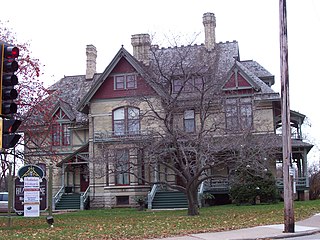
The Hearthstone Historic House Museum is a historic home in Appleton, Wisconsin, United States that has been converted into a museum. On September 30, 1882, it became the first residence in the US powered by a centrally located hydroelectric station using the Edison system. At that time, the house was the residence of Henry James Rogers, a paper company executive and entrepreneur. It was listed on the National Register of Historic Places on December 2, 1974. The house was previously known as the Henry J. Rogers House.

The Waucantuck Mill Complex was a mill complex in Uxbridge, Massachusetts. Despite its 2010 demolition, it is still listed on the National Register of Historic Places.

Watkins Mill in Lawson, Missouri, United States, is a preserved woolen mill dating to the mid-19th century. The mill is protected as Watkins Woolen Mill State Historic Site, which preserve its machinery and business records in addition to the building itself. It was designated a National Historic Landmark and added to the National Register of Historic Places in 1966 in recognition for its remarkable state of preservation. The historic site is the centerpiece of Watkins Mill State Park, which is managed by the Missouri Department of Natural Resources.

Main Street Commercial Historic District is a historic district in Reedsburg, Wisconsin that was listed on the National Register of Historic Places in 1984. It was listed alongside the Park Street Historic District. The district consists of 21 commercial buildings. Eighteen of the buildings are brick and three are of stone construction.

This is a list of the National Register of Historic Places listings in Sauk County, Wisconsin. It is intended to provide a comprehensive listing of entries in the National Register of Historic Places that are located in Sauk County, Wisconsin. The locations of National Register properties for which the latitude and longitude coordinates are included below may be seen in a map.

This is a list of the National Register of Historic Places listings in Outagamie County, Wisconsin. It is intended to provide a comprehensive listing of entries in the National Register of Historic Places that are located in Outagamie County, Wisconsin. The locations of National Register properties for which the latitude and longitude coordinates are included below may be seen in a map.

This is a list of the National Register of Historic Places listings in Ozaukee County, Wisconsin. It is intended to provide a comprehensive listing of entries in the National Register of Historic Places that are located in Ozaukee County, Wisconsin. The locations of National Register properties for which the latitude and longitude coordinates are included below may be seen in a map.

The Cedarburg Mill is a former gristmill in Cedarburg, Wisconsin that is listed on the U.S. National Register of Historic Places. Located the on Cedar Creek, the building was constructed in 1855 by Frederick Hilgen and William Schroeder to replace a smaller wooden mill from the 1840s. At the time of its construction, the five-story structure was the tallest building in Cedarburg.

The Wayside House is a historic house located in Cedarburg, Wisconsin. It was built by Frederick Hilgen, who later co-owned the Cedarburg Mill, and is considered the father of Cedarburg. It was added to the National Register of Historic Places on March 17, 1982.

J. B. Courtney Woolen Mills are textile manufacturing mills in Appleton, Wisconsin, United States. The company was originally owned by the Kelley family and was purchased by the Courtney family in 1904. Afterwards, the company changed its name from Kelley Knitting Company to J. B. Courtney Woolen Mills. The mills added to the National Register of Historic Places in 1993 for their industrial and architectural significance.

The Winooski Falls Mill District is located along the Winooski River in the cities of Winooski and Burlington, Vermont, in the United States of America. It encompasses a major industrial area that developed around two sets of falls on the river in the 19th century.
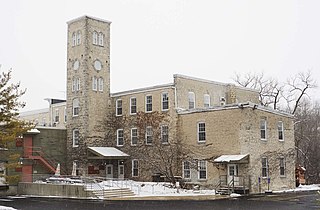
The Cedarburg Woolen Co. Worsted Mill is a former woolen mill on the Milwaukee River in Grafton, Wisconsin. In the late-1800s, the Cedarburg Woolen Company in neighboring Cedarburg decided to expand their production by opening a second mill.

The Hilgen and Wittenberg Woolen Mill is a former textile factory in Cedarburg, Wisconsin. Built in 1864, the mill was one of many wool- and flax-processing factories that opened during the American Civil War, due to a shortage of cotton textiles formerly supplied by southern states. The mill produced yarns, blankets, and flannels, and was the largest woolen mill west of Philadelphia in the 19th century. The mill closed in 1968 and has since become a commercial complex called the "Cedar Creek Settlement," containing restaurants and stores.
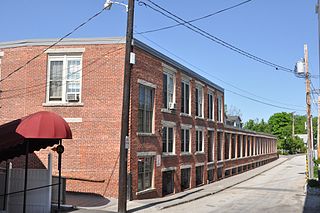
The Milford Cotton and Woolen Manufacturing Company is a historic mill complex at 2 Bridge Street in the center of Milford, New Hampshire. Developed between 1813 and World War I, it is one of the few surviving mill complexes in Milford, whose name is derived in part from "mill". The buildings were listed on the National Register of Historic Places in 1982. The complex has been converted into residential use.

The Sawyer Woolen Mills is a historic textile mill complex at 1 Mill Street in Dover, New Hampshire. Built in stages between 1873 and 1939, the mill complex is one of New Hampshire's most intact mill complexes, reflecting multiple architectural styles which were retained by addition to the complex rather than by the demolition of older buildings. The mills were listed on the National Register of Historic Places in 1989.
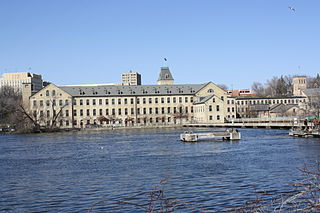
The Fox River Paper Company Historic District, now known as the Historic Fox River Mills, is a complex of paper mill buildings in Appleton, Wisconsin, United States, built from 1883 to 1915. The historic district includes the Romanesque-styled Ravine/Rag Mills, the Italianate-styled Lincoln Mill which originally milled flour, and the Italianate-styled Fox River Mill. The site is now used as apartments but also retains a functioning hydroelectric canal and privately owned generating station. This hydroelectric infrastructure continues a tradition of electricity from water power dating from the 1880s which makes the Lower Fox River the oldest hydroelectric generation region in the United States.
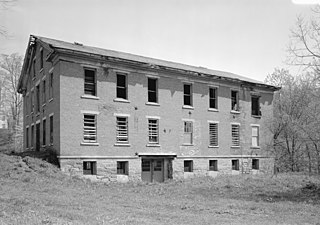
Yount's Woolen Mill and Boarding House is a historic woolen mill and boarding house located in Ripley Township, Montgomery County, Indiana. The boarding house was built in 1851, and is a two-story, L-shaped, Late Federal style brick building. It has a gable-on-hip roof and two-story porch on the rear side. The mill was built in 1864, and is a 2+1⁄2-story brick building on a raised basement with Greek Revival style design elements. Also on the property are the remains of an 1849 frame mill, an 1867 brick building, dam and mill race. The Yount Mill was contracted by the U.S. Government to manufacture Army uniforms during both the American Civil War and Spanish–American War.
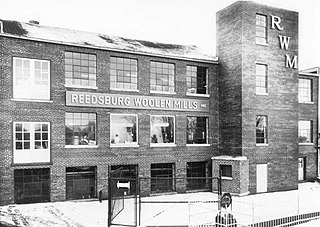
The Reedsburg Woolen Mill was a historic woolen mill along the Baraboo River in Reedsburg, Wisconsin. The woolen mill was the largest employer in Reedsburg for much of its life, employing over 200 people. The woolen mill was built in 1891 and lasted until 1968, when most of it burned down, leaving the office building intact. It was added to the National Register of Historic Places in 1984.
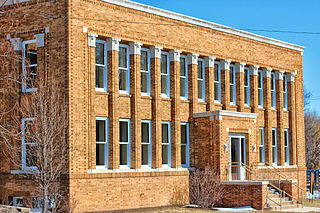
The Island Woolen Company Office Building is an office building located in Baraboo, Wisconsin, United States, along the Baraboo River. The "island" where the building is located is actually a horseshoe bend in the Baraboo River. In 1839–1840 a dam and sawmill was built across the Baraboo River. In 1863 The Island Woolen Mill was constructed on the east side of the bend, with a raceway constructed to deliver water to the mill. The mill operated mostly successfully through the 1800s and by the early 20th century needed more space. The office building was built in 1917 and housed offices for the Island Woolen Company. It was built in the prairie school style by Claude and Starck architects from Madison Wisconsin, McFetridge the owner of the company, who had worked with and consulted with Frank Lloyd Wright, contributed to the design and finish of the building. The mill and office building continued to operate until its closure in 1949. The mill's dam was removed in 1997.
References
- ↑ "National Register of Historic Places Inventory/Nomination: Appleton Woolen Mills".
- ↑ "218 East South Island Street | National or State Registers Record". Wisconsin Historical Society. 2012-01-01. Retrieved 2024-05-13.